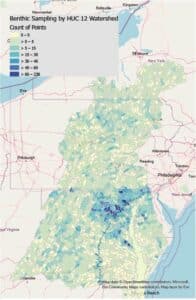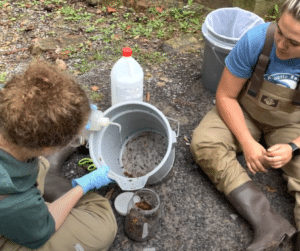Tier 2 Benthic Monitoring
Project Purpose
The Chesapeake basin-wide index of biotic integrity for stream macroinvertebrates, or “Chessie BIBI”, is a multi-metric index of biological health for freshwater streams and small, wadeable rivers in the Chesapeake Bay watershed. It serves as an “effective tool to track progress towards the CBP Stream Health management goal” (Interstate Commission on the Potomac River Basin). The index also identified many areas of the watershed that have little or no data. CMC Service Providers and volunteers will leverage monitoring efforts currently being done in these areas and help extend the Chesapeake Bay watershed area coverage of the Stream Health assessment.
Background
This protocol developed by the CMC is a new method of collecting and preserving benthic macroinvertebrates meant to support a special study that will contribute to filling data gaps within the Chessie BIBI and promote the ongoing assessment of Chesapeake Bay stream health. The CMC team worked with the CBP Stream Health Workgroup to develop a volunteer friendly protocol based off of the Virginia Department of Environmental Quality, Pennsylvania Department of Environmental Protection and Maryland Stream Waders programs. The CMC team will work with existing monitoring groups to incorporate this collection protocol into their routine monitoring at sites within low or no data watersheds.

Get Involved
If your organization works in an un-sampled or under-sampled area (white and light blue watersheds on the map to the left), or you are willing to travel to these areas, we want you to join this special project! Contact your CMC service provider to get started, your group will then need to follow these steps:
-
Work with the CMC to select your monitoring sites in identified gap watersheds
-
Complete the protocol certification process
-
Pick up provided equipment from your nearest CMC service provider
-
Collect at least 1 sample at your designated site or sites to help us reach our goal of reaching 100 sites by 2027
-
Return your equipment and sample to your CMC service provider to be sub-sampled and sent to Wheeling Lab for analysis.
Benthic samples will be collected, preserved, and sent to the EPA Wheeling Lab to be identified and classified down to the family level. Your sample’s family-level identification will be shared with you and the final data will become part of the history documented in the CMC Chesapeake Data Explorer database.
Sample Collection Certification Process



Sub-Sampling Participation Process
Once samples are collected, they may be sub-sampled prior to sending to the Wheeling Lab. The CMC service providers (ACB, IWLA, and ALLARM) will host sub-sampling days, where volunteers will assist the CMC staff in picking (or sub-sampling) the macroinvertebrates from the samples to get a clean (bug only, no leaves, sticks or other debris) sample to send to the lab.
The CMC team will advertise volunteers days as needed throughout the year. In order to get involved, you will need to watch a short introduction video and review the resources below.

